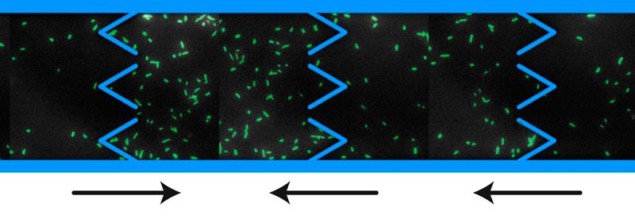
Physicists in the US are the first to show that E. coli bacteria can work together to swim through a tiny ratchet that would normally block individual organisms. The research, which combines experiments on live bacteria with theoretical modelling, could help scientists to gain a better understanding of how micro-organisms move in confined spaces such as the human gut.
E. coli are rod-shaped bacteria about 2 µm long that can be found in the large intestines of warm-blooded animals. Like many other micro-organisms, E. coli can move using whip-like structures called flagella. This movement often occurs in response to changes in the local concentration of certain chemicals – a process called chemotaxis.
Now, however, Robert Austin, Guillaume Lambert and David Liao at Princeton University in the US have shown that groups of E. coli make collective use of chemotaxis in order to navigate through tiny barriers. The team came to this conclusion by watching how the bacteria move through a microchannel that is 100 µm wide and about 13 mm long.
The microchannel is divided into 85 succesive chambers by walls, which act like microscopic ratchets. If a bacterium swims in one direction through the ratchet, it is guided by funnel-shaped structures into the next chamber. But if a bacterium swims in the opposite direction – against the bias – it is likely to be blocked from entering the next chamber.
Bacterial bands
In their experiment, Austin and his team introduced bacteria into the chamber at one end of the microchannel, in which most of the ratchets were arranged to prevent the micro-organisms from reaching the other end. When fewer than about 200 bacteria were in the first chamber, none of the micro-organisms could swim to the opposite end of the microchannel.
But at higher concentrations, the bacteria formed “travelling bands” that worked together to find their way through the ratchets. For example, when 1000 bacteria were present, the band was able to travel the entire length of the microchannel in about two hours.
The team believes that this collective behaviour is related to how the bacteria modify their environment by consuming nutrients. As the micro-organisms consume the local food supply, a nutrient gradient builds up that directs the bacteria towards regions of plenty – and ultimately through a reverse-bias ratchet and into the next chamber.
To understand how the bacteria were beating the ratchets the team used a model based on the “Keller–Segel equations”, which were formulated 40 years ago to explain why chemotaxis causes some micro-organisms travel in bands through capillary tubes. At low bacterial densities, the equations predict an exponential decline in the number of bacteria as a function of distance along the microchannel, which is exactly what the researchers saw in their experiments. Above a certain concentration, however, the Keller–Segel equations predict that the chemotaxis will cause bacteria to make their way through the microchannel in a pulse – which is exactly what the team saw.
Collective benefits
Lambert and Liao told physicsworld.com that they believe that the ability to beat ratchets could have important implications for our understanding the behaviour of some micro-organisms. For example, the ability to remain trapped until their numbers reach a critical level could benefit those micro-organisms whose survival hinges on collective behaviour.
“In other words, we could ask whether the trapped state is ‘a failure to escape’ or instead a ‘success’ in remaining sheltered,” say the researchers.
According to Lambert and Liao, natural environments such as tissue could include a variety of asymmetric barriers and therefore trapped and travelling configurations of micro-organisms could occur in biological systems.
The discovery could also have important implications for the design of “cancer traps” – ratchets that could someday be placed in the body to prevent the migration of cancer cells. “Our results with bacteria lead us to ask whether cancer cells might achieve densities sufficient for escaping the traps,” say Lambert and Liao.
Breeding better escapers
The team is now planning to find out if it can breed a strain of bacterium that is better at escaping the ratchets than the wild-type strain used in previous experiments. “Our system provides a relatively simple selection pressure, which could allow us to relatively easily select only for cells which can escape the funnels,” the researchers say.
Jane Hill, an environmental microbiologist at the University of Vermont in the US, describes the work as “interesting” and suggests that it could be relevant to the large intestine, where bacteria may be trapped between structures called microvilli. However, she points out that microvilli are larger than the ratchets in the Princeton experiment.
The work is described in Phys. Rev. Lett. 104 168102.



